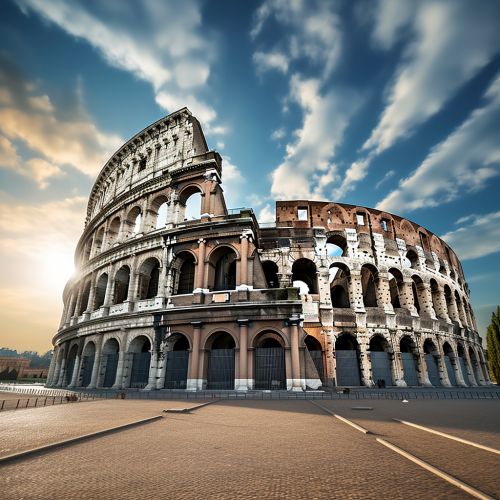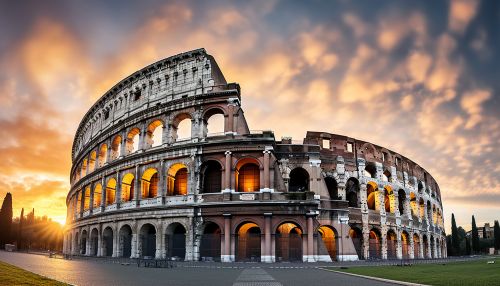Roman architecture
Origins and Development
Roman architecture, a term that covers the architectural practices of the Roman Republic and later the Roman Empire, includes structures built throughout the vast reach of Rome's dominion. The Romans adopted and adapted a variety of architectural styles from the cultures they conquered. However, the Romans also innovated, creating new architectural forms and construction techniques that have had a lasting impact on architecture worldwide.
The roots of Roman architecture can be traced back to the Etruscans, a sophisticated civilization north of Rome in Etruria. The Romans adopted Etruscan use of the arch and engineering skills, which were critical in the development of Roman architectural forms, particularly in the construction of aqueducts, bridges, and roads.
Architectural Styles and Innovations
Roman architecture is characterized by grandeur of scale, complexity of geometric forms, and a regularity of parts as demonstrated in the Colosseum. The Romans were the first civilization to fully exploit the architectural forms of the arch, the vault, and the dome. They also innovated in the use of building materials, particularly the use of concrete.


The Arch
The arch was a crucial element in Roman architecture. The Romans used it in a variety of ways, from monumental arches celebrating military victories, such as the Arch of Constantine, to functional uses in buildings and infrastructure. The arch allowed the Romans to build larger, more stable structures than ever before.
The Vault
The vault, an arched structure that extends in depth, was another Roman innovation. The Romans used vaults to construct ceilings and roofs, most notably in their bathhouses and basilicas. The most famous example of a vaulted structure is the Pantheon, which features a massive domed vault.
The Dome
The dome, a hemispherical structure evolved from the arch, was another Roman architectural innovation. The Romans used domes to create impressive interior spaces, such as the Pantheon's coffered dome, which remains the world's largest unreinforced concrete dome.
Concrete
The Romans were the first to use concrete on a massive scale. They developed a type of concrete, known as Roman concrete or opus caementicium, which was stronger and more durable than previous types. This allowed the Romans to build larger and more complex structures.
Notable Roman Buildings
Roman architecture is renowned for its grandeur, complexity, and innovative design. Some of the most notable Roman buildings include the Colosseum, the Pantheon, and the Baths of Caracalla.
The Colosseum
The Colosseum, officially known as the Flavian Amphitheatre, is perhaps the most iconic example of Roman architecture. It is the largest amphitheater ever built and is considered one of the greatest works of Roman architecture and engineering.
The Pantheon
The Pantheon, a former Roman temple, is another iconic example of Roman architecture. Its dome, with a central opening (oculus), is a defining example of Roman architectural innovation. The Pantheon's design, proportions, and concrete construction have been celebrated for centuries as a testament to Roman ingenuity.
The Baths of Caracalla
The Baths of Caracalla, one of the largest and best-preserved examples of an ancient spa, demonstrate the Roman mastery of water supply and heating systems, as well as their skill in creating vast, harmonious spaces.
Influence on Later Architecture
Roman architecture has had a profound influence on later architectural styles, particularly during the Renaissance and Neoclassical periods, and continues to influence modern architecture. The Romans' use of the arch, vault, and dome, their development of concrete, and their assembly methods have all been foundational to the evolution of Western architecture.
